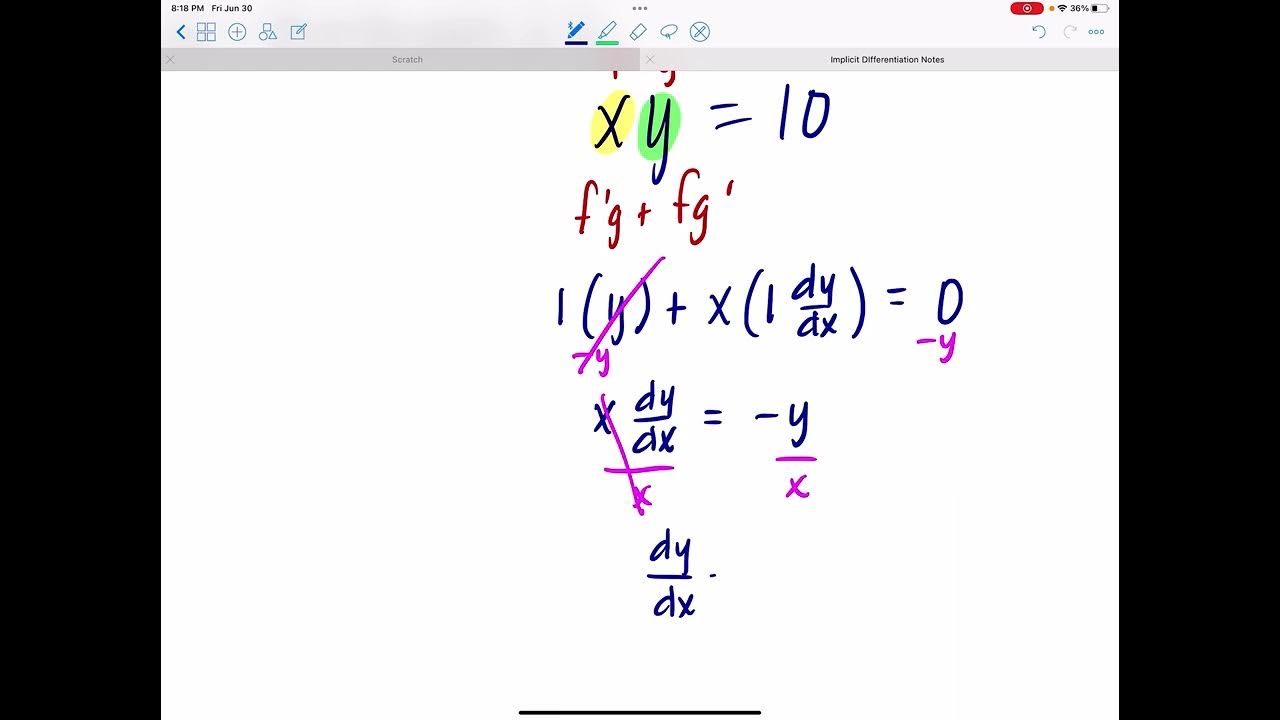Calculus 1: Implicit Differentiation Examples
TLDRThis video script introduces the concept of implicit differentiation, a technique used when solving for y in an equation is impractical. The instructor demonstrates how to take the derivative of both sides of an equation, applying the power rule and chain rule as necessary. Examples are given, including differentiating an equation involving cosine and sine functions, and an equation that can be rearranged to isolate y. The instructor emphasizes that the result of implicit differentiation will contain both x and y, which is normal. The script concludes with an invitation to visit the instructor's website for more calculus examples and step-by-step solutions.
Takeaways
- 📚 Implicit differentiation is a technique used when solving for y is impractical or difficult.
- 🔍 The process involves taking the derivative of both sides of an equation to maintain equality.
- 📉 The derivative of x^4 is 4x^3 using the power rule.
- 🔄 When differentiating y^2, consider y as a function of x, resulting in 2y * y' by the chain rule.
- 🌐 For implicit differentiation, the solution will contain both x and y, which is normal.
- 📐 The derivative of cos(x) is -sin(x), and for sin(y), it's cos(y) * y' by the chain rule.
- ✂️ The quotient rule can also be used for implicit differentiation, as shown with the example 1/x + y = 10.
- 🔄 After differentiating, rearrange the terms to solve for y', which represents the derivative of y with respect to x.
- 📝 The example 4x^3 + 2y + 1 = 0 results in y' = -4x^3 / (2y + 1) after grouping and simplifying.
- 📚 The instructor provides additional resources on their website with over 400 calculus questions solved step by step.
Q & A
What is implicit differentiation?
-Implicit differentiation is a technique used when solving for y is not practical to take a derivative, and it involves taking the derivative of both sides of an equation that does not explicitly solve for y.
Why is implicit differentiation necessary?
-Implicit differentiation is necessary when the equation is complex and solving for y explicitly would be impractical or very difficult.
How does the process of implicit differentiation work?
-In implicit differentiation, you take the derivative of each term on both sides of the equation with respect to x, treating y as a function of x, and then solve for the derivative of y with respect to x (denoted as y' or dy/dx).
What is the power rule used in the script?
-The power rule is a basic differentiation rule that states if you have a function of the form f(x) = x^n, its derivative is f'(x) = n*x^(n-1). In the script, it is used to differentiate x to the fourth power, resulting in 4x cubed.
What is the chain rule mentioned in the script?
-The chain rule is a fundamental principle in calculus that is used when differentiating composite functions. It states that the derivative of a composite function is the derivative of the outer function times the derivative of the inner function. In the script, it is used when differentiating y squared, resulting in 2y times the derivative of y with respect to x (y').
How is the derivative of a constant handled?
-The derivative of a constant is zero. In the script, when differentiating the constant 7, the result is zero because the derivative of any constant is zero.
What is the quotient rule used in the script?
-The quotient rule is a method in calculus for differentiating problems where one function is divided by another. It states that if you have a function f(x)/g(x), its derivative is [g(x)f'(x) - f(x)g'(x)] / [g(x)]^2. In the script, it is used to differentiate the expression 1/(xy).
How does the script handle the derivative of trigonometric functions?
-The script uses the derivative of cosine, which is -sine, and the derivative of sine, which is cosine. When differentiating a trigonometric function of y, the chain rule is applied, multiplying by the derivative of y with respect to x (y').
What is the final expression for y' obtained in the script for the equation x^4 + y^2 = 7?
-The final expression for y' obtained in the script for the equation x^4 + y^2 = 7 is y' = -4x^3 / (2y + 1).
What is the final expression for y' obtained in the script for the equation cos(x)sin(y) = 1?
-The final expression for y' obtained in the script for the equation cos(x)sin(y) = 1 is y' = sin(x) / cos(y).
How does the script suggest practicing implicit differentiation?
-The script suggests practicing implicit differentiation by taking the derivative of each piece of the equation separately, grouping like terms, and solving for y' without rearranging the equation to explicitly solve for y.
Where can viewers find more examples of implicit differentiation?
-Viewers can find more examples of implicit differentiation on the speaker's website, which offers free access to over 400 calculus questions solved step by step.
Outlines
📚 Introduction to Implicit Differentiation
The video script begins with an introduction to implicit differentiation, a technique used when solving for y is impractical or difficult. The instructor uses an example equation to illustrate the method, emphasizing that the derivative can be taken on both sides of an equation without altering its equality. The process involves applying the power rule and chain rule to differentiate each term separately, then rearranging the equation to solve for the derivative of y with respect to x, denoted as y'. The example provided involves an equation with x to the fourth power and a squared term involving y, leading to a final expression for y' in terms of x and y.
🔍 Applying Implicit Differentiation to Trigonometric Functions
The script continues with an example of implicit differentiation applied to a trigonometric function. It demonstrates how to differentiate both sides of the equation involving cosine and sine functions, using the chain rule to account for y as a function of x. The derivative of cosine x is negative sine x, and the derivative of sine y is cosine y times the derivative of y, which is y'. The instructor rearranges the equation to isolate y' and shows that y' equals sine x over cosine y, highlighting that the solution will contain both x and y, which is normal for implicit differentiation.
📘 Implicit Differentiation with a Quotient Rule Example
The final part of the script discusses an alternative approach to implicit differentiation using the quotient rule. The instructor could have rearranged the equation to isolate y and find y' directly, but instead, chooses to apply the quotient rule to demonstrate the process. The quotient rule is explained briefly, and the instructor differentiates the equation step by step, resulting in an expression for y' that equals y over x. The script concludes by confirming that this result is consistent with the direct method, as y over x equals 10, which was the original equation's solution.
🌐 Additional Resources for Implicit Differentiation
The script concludes with a call to action for viewers interested in learning more about implicit differentiation. The instructor invites them to visit their website, where they can access over 400 calculus questions with step-by-step solutions. This resource is offered as a way to further practice and understand implicit differentiation and other calculus concepts.
Mindmap
Keywords
💡Implicit Differentiation
💡Derivative
💡Equation
💡Power Rule
💡Chain Rule
💡Y Prime (y')
💡Cosine and Sine Functions
💡Quotient Rule
💡Rearranging Equations
💡Website
Highlights
Introduction to implicit differentiation technique.
Implicit differentiation is useful when solving for y is impractical.
To solve, take the derivative of both sides of the equation.
By taking the derivative of each term separately, we apply the chain rule.
Example: Derivative of x^4 is 4x^3 by power rule.
When differentiating y^2, consider y as a function of x.
Using the chain rule, derivative of y^2 is 2y times y'.
Combining y' terms and solving for y' involves algebraic manipulation.
Result for first example: y' = -4x^3 / (2y + 1).
Second example with trigonometric functions: derivative of cos(x) is -sin(x).
For sin(y), derivative is cos(y) times y' by chain rule.
Rearrange and solve for y': y' = sin(x) / cos(y).
Implicit differentiation solutions typically contain both x and y.
Quotient rule example: differentiate y/x without rearranging.
Combining results and simplifying yields y' = y/x.
Verification: y/x = 10 matches original rearranged form.
Invitation to visit the instructor's website for more examples and practice problems.
Transcripts
5.0 / 5 (0 votes)
Thanks for rating:





